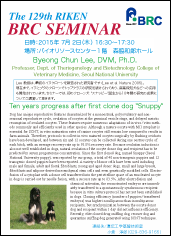The 129th RIKEN BRC SEMINAR
Ten years progress after first clone dog "Snuppy"
Date: July 2(Thu.) 2015. 16:30-17:30 (JST)
Place: Moriwaki Hall (BioResource Center Main Building 1F)
The invited lecturer
Byeong Chun Lee, DVM, Ph.D.
Professor, Dept. of Theriogenology and Biotechnology College of Veterinary Medicine, Seoul National University
Summary
Dog has unique reproductive features characterized by a monoestrual, polyovulatory and nonseasonal
reproductive cycle, ovulation of oocytes at the germinal vesicle stage, and delayed meiotic
resumption of ovulated oocytes. These features require numerous adaptations of in vivo / vitro methods
commonly and efficiently used in other species. Although a mature oocyte with MII cytoplast is
essential for SCNT, in vitro maturation rates of canine oocytes still remain low compared to results in
farm animals. Therefore, protocols to collect in vivo matured oocytes surgically by flushing oviducts
have been developed, and between six and 12 oocytes can be collected during one oestrus cycle of
each bitch, with an average recovery rate up to 93.8% recovery rate. Because ovulation induction is
also not well established in dogs, natural ovulation of the oocyte donor dog and recipient has to be
predicted by serum progesterone concentration. Since the first cloned dog, named Snuppy (Seoul
National University puppy), was reported by our group, a total of 40 non-transgenic puppies and 12
transgenic cloned puppies have been reported. A variety of donor cells have been used including
male and female, adult and foetal fibroblasts, young and aged donor dogs, small and large breeds,
fibroblasts and adipose-derived mesenchymal stem cells and even genetically modified cells. Electrofusion
of a cytoplast with a donor cell transferred into the perivitelline space of an enucleated oocyte
in dogs is carried out by needle fusion, with a success rate up to 83.5%. After electrofusion and
chemical activation, the reconstructed embryos are immediately transferred to a spontaneously synchronous recipient
because in vitro culture protocol has not yet been established
in dogs. Cloning efficiency (number of puppies / transferred
embryos) was higher in nulliparous than in multiparous
recipients, but synchronization between the oocyte donor
dog and recipient within 1 day did not influence efficiency.
Recently, elite cloned drug sniffing dog, rescuer dog and
quarantine sniffing dog generated using SCNT technique.
